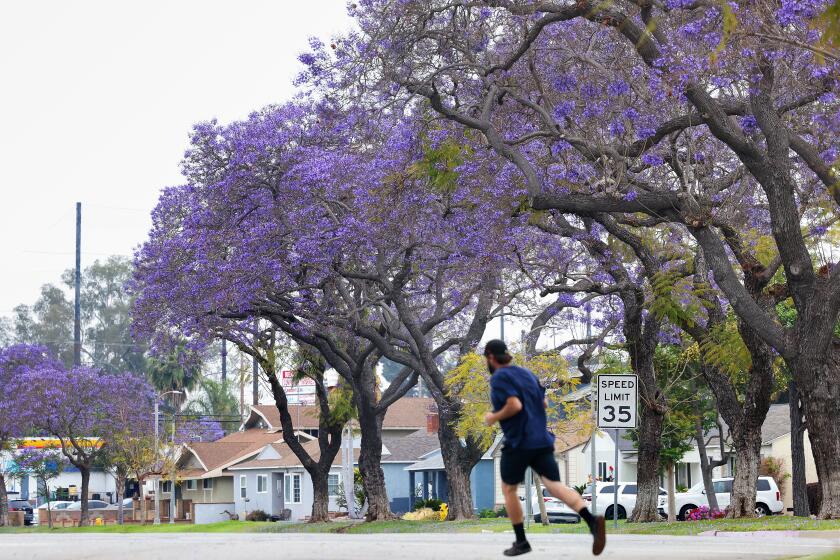Gardening : Cooler Days Mean It’s Moving Time for Plants : Transplanting: There are many reasons why the garden may need some rearranging. And now is the time to do it.
For many Southland gardeners, this is moving time. Plants grow the least when days are short and temperatures are cool, and they can be moved from one location to another with minimum trauma.
Faye Masey, a master gardener who, together with her husband, Curt, cultivates a fascinating 2-acre hillside garden in La Canada Flintridge, takes advantage of the slower pace in the garden at this time of the year to make necessary plant moves. Like other good gardeners, she transfers plants around in her garden for many reasons.
First, plants are deceptively small when initially set out. It’s hard to envision what a tiny 4-inch seedling will grow into. Who but a seasoned gardener would suspect, for example, that a small marguerite cutting could fatten into a 4-foot mound?
Even when we know intellectually that certain plants will become unreasonably large, it’s hard to control the desire to fill up an area at planting time. Massey calls it “gardener’s folly” in explaining how she overplanted an entry garden area, forcing her to remove two trees and transplant several large shrubs recently.
A second reason for moving plants is the changing environment in any garden. New homeowners typically begin with sunny gardens and root-free planting beds. As trees and shrubs mature, planting areas become shady and root-filled.
The day lilies or roses will no longer bloom because the pepper or ash trees steal the sunlight and soil nutrients. Or a garden tree is removed, and suddenly a formerly shady area becomes sunny, necessitating the transfer of plants to more appropriate areas.
A third reason for moving plants is that the soil condition or individual microclimate isn’t desirable for a plant. When a perennial or shrub or vine doesn’t grow well in one area, it should be moved to another spot where it may thrive.
Masey’s penstemon plants, for example, were puny in the front garden, so she moved them to a border strip next to a walkway where they basked in sun but enjoyed a cool root run. Here they grew so vigorously that they overran the walkway. These peripatetic plants may be on the road again soon.
Another reason for moving plants is aesthetic. Some plant combinations do not turn out as well as we anticipate. Vita Sackville-West, the respected British garden authority, said that successful gardening was largely a matter creating good marriages.
We gardeners play the role of matchmaker in attempting to join pleasing colors and appealing forms that result in a peaceful, harmonious garden union. But sometimes we fail. And when incompatibility results, divorces are in order. The resolute and sometimes ruthless gardener must separate warring horticultural partners.
One of the most jarring plant marriages I’ve seen is the coupling of pink India hawthorn ( Rhaphiolepis indica ) and orange or yellow gazanias. Because these are both rugged plants that bloom in the sun, they are often planted together, creating a color disharmony destined for divorce court. Pink azaleas with orange clivias is another discordant marriage of convenience.
This is a good time to assess the garden and correct those problems that require the moving of plants. Avoid moving any plants, however, that are growing vigorously or that are about to bloom.
The most likely candidates for transplanting are perennials that have outgrown their assigned quarters. At this time of the year you can safely divide perennials with fibrous roots, such as yarrow, lamb’s ear, agapanthus, Shasta daisy, day lily and obedience plant ( Physostegia ) . Massey finds that plant moving is most successful when she follows these procedures:
Begin by soaking the plants to be divided about two or three days before working with them. Prepare the area where the plants will be transplanted. Work in organic fertilizers and soil amendments. (Massey favors mushroom compost because of a local supplier.) Remember that unlike annuals, perennials remain in the same spot for many years. The soil must be fertile to begin with because it can’t be corrected after one season.
On moving day, try to work in the cool of the day, either morning or late afternoon. With a shovel, dig under the perennial clump and lift it out of the ground. The root systems of some plants, like Shasta daisies, are easily pulled apart by hand. Plants with dense roots, such as day lilies, may require stronger tools, such as two garden pitch forks placed back to back to pry apart the roots.
Plant the divisions slightly below the surface, firming the soil around each root portion. Water enough to dampen the soil but don’t make the area soggy. Newly transplanted root divisions require little water if the weather is cool. In a week or two, apply a diluted solution of fertilizer. Massey mixes a bucket of concentrated fish fertilizer, attaches a siphonex, and fertilizes a large area by using the garden hose.
Once transplants have settled in, Massey applies mulch to keep the soil from compacting. You can make your own organic compost or purchase bags of redwood compost.



